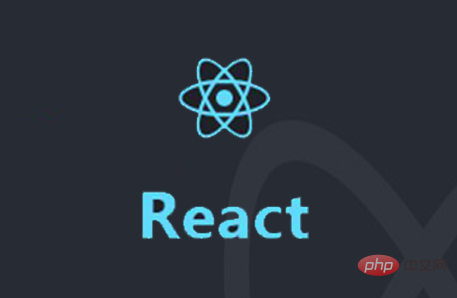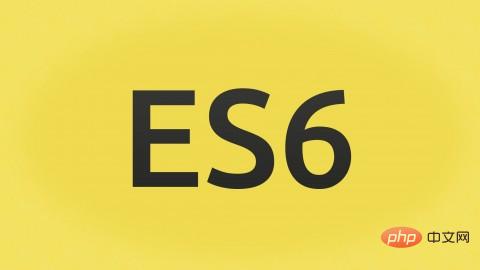What are react and es6
react is a declarative, efficient and flexible JavaScript development framework launched by Facebook for building user interfaces; it provides programmers with a model in which sub-components cannot directly affect outer components. When data changes Efficient updates to HTML documents and clean separation between components in modern single-page applications. es6 is the next version standard of JavaScript. Its goal is to make the JavaScript language can be used to write complex large-scale applications and become an enterprise-level development language.

The operating environment of this tutorial: windows7 system, ECMAScript 6&&react18 version, Dell G3 computer.
What is react
react.js is a JavaScript development framework launched by Facebook for building user interfaces.
React is a declarative, efficient and flexible JavaScript library for building user interfaces. React allows you to combine short, independent code snippets into complex UI interfaces. These code snippets are called "components".
Because the design idea of React is extremely unique, it is a revolutionary innovation, has outstanding performance, and the code logic is very simple. Therefore, more and more people are beginning to pay attention to and use it, thinking that it may be the mainstream tool for web development in the future.

#React is an open source JavaScript library that provides views of data rendered into HTML. React views are typically rendered using components that contain other components specified in custom HTML tags. React provides programmers with a model in which child components cannot directly affect outer components, efficient updates to HTML documents when data changes, and clean separation between components in modern single-page applications.
The advantages of React are:
More suitable for large applications and better testability
Web and mobile native APP take all
A larger ecosystem, more support and easy-to-use tools
More suitable for medium and large projects
What is es6
es6 full name is ECMAScript6 (the 6th version of ECMAScript), which was released in 2015 The JavaScript language standard officially released in June 2015 is officially called ECMAScript 2015 (ES2015).
ECMAScript 6 has basically become the industry standard, and its popularity is much faster than ES5. The main reason is that modern browsers support ES6 very quickly, especially Chrome and Firefox browsers, which already support Most features in ES6.
Since then, ECMA Script has released a major version every year to add some important features, which we call ES6.

Understand the relationship between ES and JS
ES = ECMAScript is a 'standard' for dynamic scripting languages, JS = JavaScript is the standard, default, and mainstream 'implementation' of ES. Due to trademark rights issues, the language standard formulated by the European Computer Association cannot be called JS, but can only be called ES;
The purpose of the new ES6 standard is: JS can be used to develop large-scale web applications and become an enterprise-level development language. The enterprise-level development language is: suitable for modular development and has good dependency management;
Why should you learn ES6? What is ES6 used for?
ES5 cannot meet the current situation where the front-end is becoming more and more complex and huge. It can be said to be outdated. ES6 is an enhancement and upgrade to ES5.
1. Mainstream browsers have fully supported ES6
2. Newer front-end frameworks in the industry have fully used ES6 syntax
3. WeChat applet , uni-app, etc. are all based on ES6 syntax
4. Starting from employment, small and medium-sized companies, full stack, one more skill on the resume, and the trial period can also get started faster.
Variable
-
let
Only one let variable can be declared in a scope. If the child If a let variable is also declared in the scope, it will not affect the let variable in the parent scope. -
var
Multiple var variables can be declared in one scope. If a var variable is also declared in the child scope, it will also affect the var variable in the parent scope. -
const
Constant, equivalent to final, cannot be modified. -
global
Variables that do not declare a variable type default to global variables (window attributes).
Object-oriented
-
Principle
The object-oriented features of JavaScript are based on prototypes and constructors, which are different from the common ones based on classes. JavaScript does not provide language-level features of object inheritance, but does so through prototype copying. - Three methods of creating objects
1. {pojo}(实例变量、实例方法、get、set)
2. function(实例变量、实例方法、prototype、apply、call)
3. class(实例变量、实例方法、prototype、extends、super)prototype
Only functions and classes Only prototypes exist, and their significance lies in dynamically adding instance variables and instance methods and implementing inheritance.
Inheritance
- ##call/apply In the inheritance relationship, the subclass applies to the parent This keyword should be used when passing parameters in a class
- extends Used in inheritance relationships, A extends B, then A is the parent class of B
- super ## This method of calling the parent class in the sub -category uses the keywords
- # Next (prototype inheritance) constructor inheritance (inherited properties)). This method can avoid the disadvantages of being unable to implement multiple inheritance in prototype chain inheritance, being unable to pass parameters to the parent class constructor when creating a subclass instance, and also avoiding the disadvantages of being unable to inherit prototype properties/methods in constructor inheritance.
function Person(name,age){ /* 父类 */ this.name = name || 'father'; //实例变量 this.namesonF = this.nameson; this.age = age; this.talk = function(){alert("talk");}; //实例方法 }; function Son(name){ /* 子类 */ this.nameson = name || 'son'; // Person.call(this,'name',18); //继承:构造继承,复制父类的实例属性给子类,不能继承原型属性/方法 Person.apply(this,['name',18]); //继承:构造继承,复制父类的实例属性给子类,不能继承原型属性/方法 } // Son.prototype = new Person("zhangsan",19); //继承:原型链继承,父类的实例作为子类的原型,拷贝属性两次,不合理 Son.prototype = Person.prototype; //继承:原型链继承,父类的实例作为子类的原型 Person.prototype.publicParam="param1"; //动态添加实例变量 Person.prototype.talk=function(){alert("talk");} //动态添加实例方法 var son = new Son(); //实例化对象,调用构造函数(constructor)Copy after login
- ES6 inheritance method
- ES6 inheritance creates a new way of writing, which is very similar to Java, Scala and other languages, and uses combined inheritance by default ( Prototype chain inheritance (inheriting prototypes) construct inheritance (inheriting properties)).
class Point { constructor(x, y) { this.x = x; //实例变量 this.y = y; } } class Son extends Point { constructor(z, w) { super(z,w); this.z = z; //实例变量 this.w = w; } } var son = new Son(1,2);Copy after login
arrow functions Arrow function is a new syntax added in ES6, which is similar to Java's lambda and scala's functional expression. The syntax is very similar
- code
var single = a => console.log(a); var single = (a) => (console.log(a)); var single = (a, b) => {console.log(a + b)}; var single = (a, b) => {return a + b};Copy after login
template string Template String, new syntax for string concatenation
- Code
var templateStr = () => { var str1 = "adsf\nsdfa"; var template1 = `<ul><li>first</li> <li>second</li></ul>`; var x = 1; var y = 2; var template2 = `${x} + ${y} = ${x + y}`; var template3 = `${lettest4()}`; console.log(str1) console.log(template1) console.log(template2) console.log(template3) }Copy after login
destructuring Reconstruction/deconstruction, syntax for variable interaction
- Code
var destructuring = () => { var [a,b,...c]=[1,2,3,4,5,6,7,8,9,10]; let [temp="replaceString"] = ["tempString"]; let [age2, [{name: fname},{age: fname2="replaceString"}]] = [20, [{name: 'qc'},{}]]; const [aa,bb,cc,dd,ee,ff]="hello"; let {name="replaceName",age,id}={name:'cursor',age:19,id:'vc6dfuoc91vpdfoi87s'}; let {type:tipType,min:minNumber}={type:'message',min:20}; let {sin,cos,tan,log}=Math; var fun = function({x,y}={}){return [x,y];} fun({x:100,y:2}); [a,b]=[b,a]; //交换 var map = [1,2,3] var map=new Map(); map.set("id","007"); map.set("name","cursor"); for(let [key,value] of map){} for(let [key] of map){} for(let [,value] of map){} var arr = [1,2,3,4] for(let val of arr){val} }Copy after login
arguments Actual parameters, variables added in ES6 to directly read parameters
- Code
- [Related recommendations : javascript video tutorial
function argumentsTest(a,b) { for(let val of arguments) {console.log(val) } }Copy after loginThe above is the detailed content of What are react and es6. For more information, please follow other related articles on the PHP Chinese website!

Hot AI Tools

Undresser.AI Undress
AI-powered app for creating realistic nude photos

AI Clothes Remover
Online AI tool for removing clothes from photos.

Undress AI Tool
Undress images for free

Clothoff.io
AI clothes remover

Video Face Swap
Swap faces in any video effortlessly with our completely free AI face swap tool!

Hot Article

Hot Tools

Notepad++7.3.1
Easy-to-use and free code editor

SublimeText3 Chinese version
Chinese version, very easy to use

Zend Studio 13.0.1
Powerful PHP integrated development environment

Dreamweaver CS6
Visual web development tools

SublimeText3 Mac version
God-level code editing software (SublimeText3)

Hot Topics
 PHP, Vue and React: How to choose the most suitable front-end framework?
Mar 15, 2024 pm 05:48 PM
PHP, Vue and React: How to choose the most suitable front-end framework?
Mar 15, 2024 pm 05:48 PM
PHP, Vue and React: How to choose the most suitable front-end framework? With the continuous development of Internet technology, front-end frameworks play a vital role in Web development. PHP, Vue and React are three representative front-end frameworks, each with its own unique characteristics and advantages. When choosing which front-end framework to use, developers need to make an informed decision based on project needs, team skills, and personal preferences. This article will compare the characteristics and uses of the three front-end frameworks PHP, Vue and React.
 Integration of Java framework and front-end React framework
Jun 01, 2024 pm 03:16 PM
Integration of Java framework and front-end React framework
Jun 01, 2024 pm 03:16 PM
Integration of Java framework and React framework: Steps: Set up the back-end Java framework. Create project structure. Configure build tools. Create React applications. Write REST API endpoints. Configure the communication mechanism. Practical case (SpringBoot+React): Java code: Define RESTfulAPI controller. React code: Get and display the data returned by the API.
 Simple JavaScript Tutorial: How to Get HTTP Status Code
Jan 05, 2024 pm 06:08 PM
Simple JavaScript Tutorial: How to Get HTTP Status Code
Jan 05, 2024 pm 06:08 PM
JavaScript tutorial: How to get HTTP status code, specific code examples are required. Preface: In web development, data interaction with the server is often involved. When communicating with the server, we often need to obtain the returned HTTP status code to determine whether the operation is successful, and perform corresponding processing based on different status codes. This article will teach you how to use JavaScript to obtain HTTP status codes and provide some practical code examples. Using XMLHttpRequest
 How to get HTTP status code in JavaScript the easy way
Jan 05, 2024 pm 01:37 PM
How to get HTTP status code in JavaScript the easy way
Jan 05, 2024 pm 01:37 PM
Introduction to the method of obtaining HTTP status code in JavaScript: In front-end development, we often need to deal with the interaction with the back-end interface, and HTTP status code is a very important part of it. Understanding and obtaining HTTP status codes helps us better handle the data returned by the interface. This article will introduce how to use JavaScript to obtain HTTP status codes and provide specific code examples. 1. What is HTTP status code? HTTP status code means that when the browser initiates a request to the server, the service
 Vue.js vs. React: Project-Specific Considerations
Apr 09, 2025 am 12:01 AM
Vue.js vs. React: Project-Specific Considerations
Apr 09, 2025 am 12:01 AM
Vue.js is suitable for small and medium-sized projects and fast iterations, while React is suitable for large and complex applications. 1) Vue.js is easy to use and is suitable for situations where the team is insufficient or the project scale is small. 2) React has a richer ecosystem and is suitable for projects with high performance and complex functional needs.
 React's Role in HTML: Enhancing User Experience
Apr 09, 2025 am 12:11 AM
React's Role in HTML: Enhancing User Experience
Apr 09, 2025 am 12:11 AM
React combines JSX and HTML to improve user experience. 1) JSX embeds HTML to make development more intuitive. 2) The virtual DOM mechanism optimizes performance and reduces DOM operations. 3) Component-based management UI to improve maintainability. 4) State management and event processing enhance interactivity.
 React and the Frontend: Building Interactive Experiences
Apr 11, 2025 am 12:02 AM
React and the Frontend: Building Interactive Experiences
Apr 11, 2025 am 12:02 AM
React is the preferred tool for building interactive front-end experiences. 1) React simplifies UI development through componentization and virtual DOM. 2) Components are divided into function components and class components. Function components are simpler and class components provide more life cycle methods. 3) The working principle of React relies on virtual DOM and reconciliation algorithm to improve performance. 4) State management uses useState or this.state, and life cycle methods such as componentDidMount are used for specific logic. 5) Basic usage includes creating components and managing state, and advanced usage involves custom hooks and performance optimization. 6) Common errors include improper status updates and performance issues, debugging skills include using ReactDevTools and Excellent
 React vs. Vue: Which Framework Does Netflix Use?
Apr 14, 2025 am 12:19 AM
React vs. Vue: Which Framework Does Netflix Use?
Apr 14, 2025 am 12:19 AM
Netflixusesacustomframeworkcalled"Gibbon"builtonReact,notReactorVuedirectly.1)TeamExperience:Choosebasedonfamiliarity.2)ProjectComplexity:Vueforsimplerprojects,Reactforcomplexones.3)CustomizationNeeds:Reactoffersmoreflexibility.4)Ecosystema






